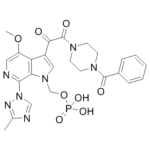This product is for research use only, not for human use. We do not sell to patients.

| Size | Price | Stock |
|---|---|---|
| 250mg | $1450 | Check With Us |
| 500mg | $2080 | Check With Us |
| 1g | $3120 | Check With Us |
Cat #: V3501 CAS #: 864953-29-7 Purity ≥ 98%
Description: Fostemsavir (BMS-663068; BMS663068; Rukobia), the phosphonooxymethyl prodrug of BMS-626529, is an approved (in 2020) antiretroviral medication for adults living with HIV/AIDS. It is a novel attachment inhibitor that targets HIV-1 gp120 and prevents its binding to CD4+ T cells. The activity of BMS-626529 is virus dependent, due to heterogeneity within gp120. In order to better understand the anti-HIV-1 spectrum of BMS-626529 against HIV-1, in vitro activities against a wide variety of laboratory strains and clinical isolates were determined. BMS-626529 had half-maximal effective concentration (EC(50)) values of<10 nm='' against='' the='' vast='' majority='' of='' viral='' susceptibility='' varied='' by=''>6 log(10), with half-maximal effective concentration values in the low pM range against the most susceptible viruses. The in vitro antiviral activity of BMS-626529 was generally not associated with either tropism or subtype, with few exceptions. Measurement of the binding affinity of BMS-626529 for purified gp120 suggests that a contributory factor to its inhibitory potency may be a relatively long dissociative half-life. Finally, in two-drug combination studies, BMS-626529 demonstrated additive or synergistic interactions with antiretroviral drugs of different mechanistic classes. These results suggest that BMS-626529 should be active against the majority of HIV-1 viruses and support the continued clinical development of the compound.
Publications Citing InvivoChem Products
Product Promise

- Physicochemical and Storage Information
- Protocol
- Related Biological Data
- Stock Solution Preparation
- Quality Control Documentation
| Molecular Weight (MW) | 583.49776 |
|---|---|
| Molecular Formula | C25H26N7O8P |
| CAS No. | 864953-29-7 |
| Storage | -20℃ for 3 years in powder formr |
| -80℃ for 2 years in solvent | |
| SMILES Code | CC1=NN(C=N1)C2=NC=C(C3=C2N(C=C3C(=O)C(=O)N4CCN(CC4)C(=O)C5=CC=CC=C5)COP(=O)(O)O)OC |
| Synonyms | BMS-663068; BMS663068; BMS-663068 dihydrate; BMS 663068; Fostemsavir |
| Protocol | In Vivo | ostemsavir (BMS-663068) has good antiviral activity in subjects infected with virus shown to be susceptible (IC50, <100 nM) to the agent. |
|---|
| Solvent volume to be added | Mass (the weight of a compound) | |||
|---|---|---|---|---|
| Mother liquor concentration | 1mg | 5mg | 10mg | 20mg |
| 1mM | 1.7138 mL | 8.5690 mL | 17.1380 mL | 34.2761 mL |
| 5mM | 0.3428 mL | 1.7138 mL | 3.4276 mL | 6.8552 mL |
| 10mM | 0.1714 mL | 0.8569 mL | 1.7138 mL | 3.4276 mL |
| 20mM | 0.0857 mL | 0.4285 mL | 0.8569 mL | 1.7138 mL |
This equation is commonly abbreviated as: C1 V1 = C2 V2
- (1) Please be sure that the solution is clear before the addition of next solvent. Dissolution methods like vortex, ultrasound or warming and heat may be used to aid dissolving.
- (2) Be sure to add the solvent(s) in order.




































